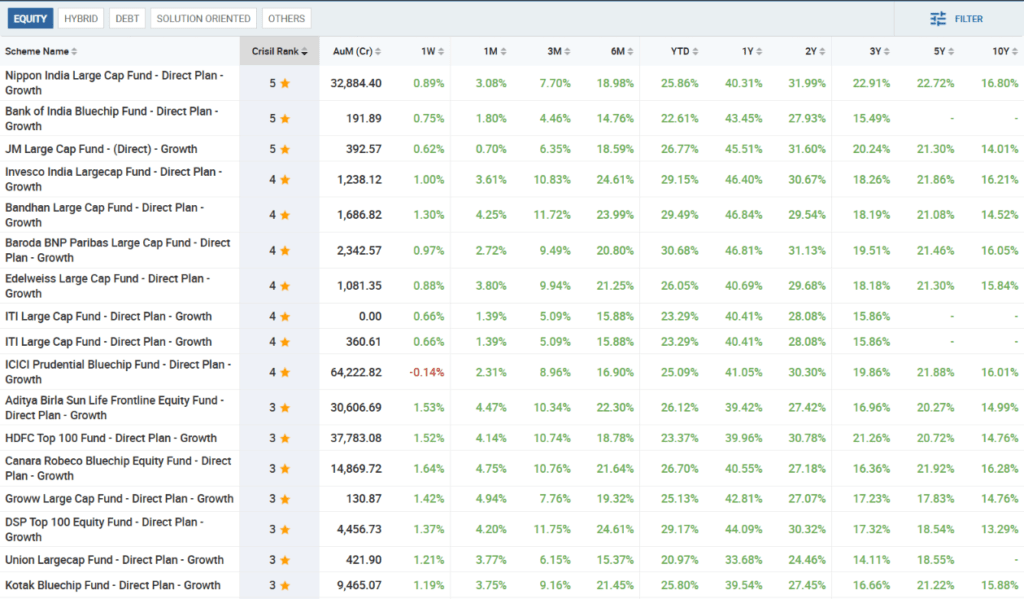Whether you are a beginner dipping your toes into the investment world or a seasoned investor seeking diversification, mutual funds offer an excellent avenue for building long-term financial security.
Updated on 15 Jan 2025, 1:47 PM

Invest in Mutual Funds; Credit: iStock
Step by step Guidance for Mutual Funds Investment
Mutual funds are investment vehicles that pool money from multiple investors to invest in a diversified portfolio of stocks, bonds, and other securities.
They are managed by professional fund managers who use the pooled money to create a balanced portfolio to achieve the best possible returns for investors.
See more: Beginner’s Guide to start Investing in India: Long-Term Growth Strategies
What Are Mutual Funds and How Do They Work?
A mutual fund collects money from many investors and invests it in various asset classes, including equities (stocks), fixed income (bonds), money market instruments, and sometimes other assets like real estate or commodities.
In a mutual fund, fund managers buy and sell securities to align with the fund’s objective, and investors receive units proportional to their investment. As the underlying securities increase in value, so do the units, and vice versa.
| professional Fund managers, company & experience | Expertise |
| 1. Prashant Jain (Over 25 years) HDFC Mutual Fund | Equity funds, manages Balanced Advantage Fund and Top 100 Fund. |
| 2. S Naren (Over 30 years) ICICI Prudential Mutual Fund | Contrarian style, value investing; manages Value Discovery Fund. |
| 3. Anupam Tiwari (Over 16 years) Axis Mutual Fund | Mid-cap and small-cap equity funds; manages Axis Small Cap Fund. |
| 4. R. Gopalakrishnan (Over 25 years) Sundaram Mutual Fund | Large-cap and multi-cap equity funds. |
| 5. Sohini Andani (Over 20 years) SBI Mutual Fund | Large-cap equities, known for managing SBI Bluechip Fund. |
| 6. R. Srinivasan (Over 25 years) SBI Mutual Fund | Small-cap and multi-cap funds; manages SBI Small Cap Fund. |
| 7. Vinay Paharia (Over 18 years) Union Mutual Fund | Multi-cap and large-cap equity funds. |
| 8. Alok Ranjan (Over 17 years) IDFC Mutual Fund | Equity research and large-cap funds; manages IDFC Core Equity Fund. |
| 9. Mahesh Patil (Over 17 years) Aditya Birla Sun Life Mutual Fund | Equity and hybrid funds; manages Frontline Equity Fund. |
Benefits of investing in Mutual Funds
Mutual funds offer several advantages that make them appealing to a wide range of investors:
- Diversification: By investing in a mutual fund, you gain exposure to a broad range of securities, reducing the risk associated with individual assets.
- Professional Management: A qualified fund manager makes investment decisions on behalf of investors, ensuring that the portfolio aligns with market trends and objectives.
- Liquidity: Mutual funds are relatively liquid, meaning you can buy or sell your units at the net asset value (NAV) on any business day.
- Cost-effectiveness: Many mutual funds, especially index funds, offer low-cost options with minimal expense ratios.
- Potential for Long-term Growth: Over time, mutual funds have the potential to grow your investments, especially when held for the long term, taking advantage of market growth and compounding returns.
see more: How Healthy Financial Habits Can Improve Both Your Wealth and Well-being – 2025
Different Types of Mutual Funds
There are various types of mutual funds available, each catering to different investor needs and goals:
- Equity Funds: Primarily invest in stocks and are ideal for investors seeking higher returns (40% – 75% per year) with a higher risk profile.
- Debt Funds: Invest in bonds and other fixed-income instruments, providing more stability but generally lower returns (~10% per year) compared to equity funds.
- Hybrid Funds: Combine both equity and debt instruments to balance risk and reward (~25% per year).
- Sector and Thematic Funds: These focus on specific sectors like technology, healthcare, or renewable energy and are suitable for investors with a particular industry focus.
- Index Funds: Track a specific market index like the Nifty 50 or S&P 500, offering broad market exposure with lower management fees.
Investors can also choose between Systematic Investment Plans (SIPs) or lump sum investments. SIPs allow you to invest a fixed amount regularly, while lump sum involves investing a large sum all at once.
SIPs are ideal for averaging out the cost over time, while lump sum investments may work well when market conditions are favorable.
see more: Top 10 High Dividend Yield Stocks in India 2025: Best Picks for Investors
How to Choose the Right Mutual Fund
Selecting the right mutual fund is crucial for achieving your financial goals. Here’s how to approach it:
1. Assess Risk Tolerance
Understand your ability to handle market fluctuations. Equity funds are riskier but offer higher returns, while debt funds are safer but provide lower returns.

Risk measurement
2. Set Financial Goals
Whether you’re saving for retirement, a down payment on a home, or your children’s education, choose a fund that aligns with your time horizon and goals.
Example 1:
- Short-Term Goals: Buying a car, vacation, emergency fund, or home renovation.
- Time Horizon: 1-3 years.
- Recommended Funds: Low-risk funds such as Liquid Funds, Ultra Short-Term Debt Funds, or Short-Term Debt Funds.
Example 2:
- Mid-Term Goals: Saving for a house down payment, children’s education, or a family wedding.
- Time Horizon: 3-5 years.
- Recommended Funds: Hybrid Funds, Balanced Advantage Funds, or Short-to-Medium Term Debt Funds.
Example 3:
- Long-Term Goals: Retirement, children’s higher education, buying a home.
- Time Horizon: 10 years or more.
- Recommended Funds: Equity Mutual Funds, ELSS (Equity Linked Savings Scheme), SIP (Systematic Investment Plan) in Equity Funds, or Index Funds.
Example 4:
- Retirement Planning: Building a retirement corpus, ensuring post-retirement income.
- Time Horizon: 15-30+ years.
- Recommended Funds: Retirement Funds, Pension Funds, Equity Mutual Funds, or Balanced Funds.
Best Long-term Stocks in India for 2025: How to Build a Wealthy Future
3. Research Fund Performance
Look at the historical performance of funds over various time periods to see how they’ve performed in different market conditions.

Historical performances; credit: moneycontrol
4. Expense Ratios and Fees
Pay attention to the cost of owning the fund. Expense ratios (annual fees) can significantly impact your returns over the long term. Lower expense ratios are generally better.
Components of Expense Ratio:
- Management Fees:
Cost charged by the AMC (Asset Management Company) for managing the fund. - Administrative Costs:
Expenses related to the day-to-day operations of the fund (e.g., record-keeping, accounting). - Distribution Fees (12b-1 Fees):
Marketing and distribution costs to promote the fund. - Other Operating Expenses:
Any additional operational costs incurred by the fund.
Formula for Expense Ratio:

Calculation of Expense ratio for mutual funds
5. Check Ratings
Utilize ratings from financial rating agencies like Morningstar or CRISIL to compare funds based on risk-adjusted returns.
How to Invest in Mutual Funds
Investing in mutual funds is a simple process that can be done online or through a broker. Here’s a step-by-step guide:
- Set Financial Goals & relevant risk: Determine why you’re investing (retirement, short-term savings, etc.) and how much you’re willing to invest.
- Choose Between SIP or Lump Sum: Based on your financial situation, decide whether you want to invest regularly via SIP or make a one-time lump sum investment.
- Select a Fund Type and Category: Based on your goals and risk tolerance, choose the type of fund (equity, debt, hybrid, etc.).
- KYC Compliance: Complete your Know Your Customer (KYC) process, which is mandatory for all mutual fund investors in India.
- Use an Online Platform: Platforms like Groww, Paytm Money, or AMC websites make it easy to start investing in mutual funds with just a few clicks.
How to Track and Manage Your Mutual Fund Investments
Once you’ve invested, it’s crucial to regularly monitor your mutual funds to ensure they’re performing as expected:
- Track Fund Performance: Regularly review your fund’s performance against its benchmark index.
- Adjust Investment Strategy: Depending on market conditions or changes in your financial situation, you may need to adjust your portfolio.
- Rebalance Your Portfolio: Periodically, it’s a good idea to rebalance your portfolio to maintain your desired level of risk. For example, you may need to shift from equity to debt as you approach your financial goal.
- Switch Between Funds: If a fund is underperforming, consider switching to a better-performing fund.
For Examples,
Portfolio Structure for Moderate Risk Tolerance:
Equity Mutual Funds (50%):
Equity funds offer higher returns but come with higher volatility. Suggested Allocation:
- Large-Cap Funds: 30%
- Mid-Cap/Small-Cap Funds: 10%
- International/Global Funds: 10%
Debt Mutual Funds (30%):
Debt funds are safer than equities and provide stable returns. They are essential for cushioning the portfolio during market volatility. Suggested Allocation:
- Short-Term Debt Funds: 20%
- Government Bonds/Corporate Bonds: 10%
Hybrid Mutual Funds (20%):
Hybrid funds provide a mix of both equity and debt, helping balance the portfolio. Suggested Allocation:
- Balanced Advantage Funds: 10%
- Aggressive Hybrid Funds: 10%
see more: How to Invest in the Stock Market with Little Money: A Comprehensive Guide
Taxation and Mutual Funds
In India, the taxation of mutual funds depends on the type of fund and the duration of your investment:
- Equity Mutual Funds: Gains from equity funds held for less than a year are considered short-term capital gains (STCG) and are taxed at 20%. Gains from funds held for more than a year are long-term capital gains (LTCG) and are taxed at 12.5% for gains over ₹1.25 lakh.
- Debt Mutual Funds: Gains from debt funds held for less than three years are taxed as per your income tax slab. Long-term capital gains from debt funds are taxed at 20% after indexation.
- Tax-saving Funds (ELSS): Equity-linked savings schemes (ELSS) offer tax benefits under Section 80C of the Income Tax Act, with a lock-in period of three years.
Common Mistakes to Avoid When Investing in Mutual Funds
Investing in mutual funds is simple, but common mistakes can hinder your returns:
- Focusing Only on Past Performance: While historical returns provide insights, they don’t guarantee future results.
- Not Aligning Funds with Financial Goals: Choose funds that align with your specific goals and risk appetite.
- Ignoring Expense Ratios: High expense ratios can eat into your returns over time.
- Lack of Diversification: Don’t put all your money into one fund or one type of asset. Diversification reduces risk.
- Emotional Decision-making: Don’t panic during market downturns. Stay focused on your long-term goals.
Managing Personal Finances in a Volatile Economy: Tips for Budgeting, Saving, and Retirement in 2025
Top Mutual Funds to Consider in 2025
As you embark on your investment journey in 2025, here are some top-performing funds across different categories:
- Equity Fund: Mirae Asset Large Cap Fund
- Debt Fund: HDFC Short-Term Debt Fund
- Hybrid Fund: SBI Equity Hybrid Fund
- Index Fund: UTI Nifty Index Fund
- ELSS Fund: Axis Long Term Equity Fund
See more: Top SIP Mutual Funds in 2025: A Comprehensive Guide for Investors
Each of these funds has consistently delivered strong performance, but always research and match them to your financial goals.
Investing in mutual funds is an excellent way to achieve financial goals, whether you’re planning for retirement or saving for the future. By selecting the right funds, understanding the tax implications, and managing your portfolio wisely, you can maximize your investment returns over time. Start small, grow steadily, and take advantage of the long-term benefits that mutual funds offer.

